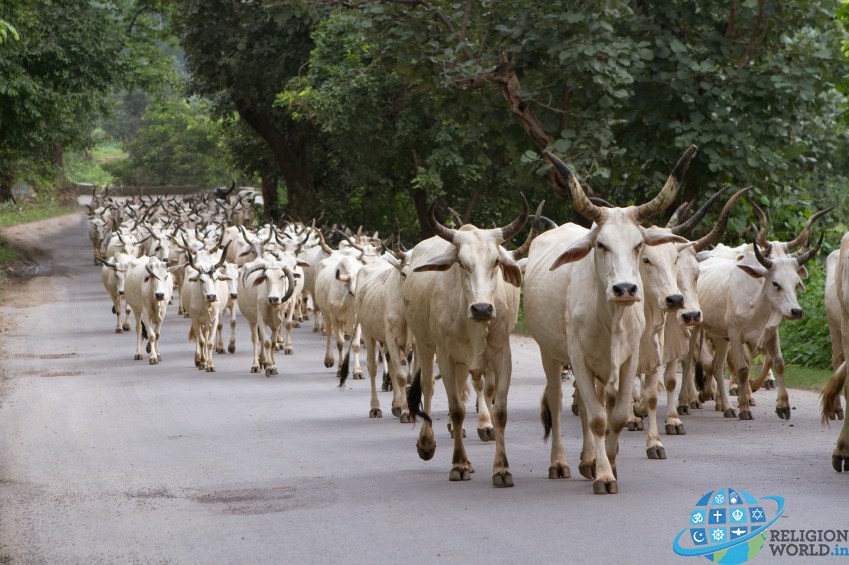Cow : Venerated and Vulnerable
- Religion World
Cow is always revered by hindus and its value for society and culture is deep due to religious reasons. Cow sheltering is not new to our country, even we have deities and castes that has inseparable relation with this sacred animal. Lord Krishna was a Yaduvanshi and till date Yadavs known for cow care and conservation. The other religious aspects of cow has teach us that “gaye hamari mata hai”
Vinoba Bhave fought his whole life for a national wide ban on cow slaughter. He very aptly said that the ‘misapprehensions of secular character of state and protection of the cow are misunderstood’. There is no incompatibility between the two. But Mahatma Gandhi was more clear in his thoughts on cow slaughter, “Cow slaughter can never be stopped by law. Knowledge, education, and the spirit of kindliness towards her alone can put and end to it. It will not be possible to save those animals that are a burden on the land or, perhaps, even man if he is a burden” said Mahatma Gandhi in 1946.
Cow is always a tricky issues for our political class. Be it Beef Ban or Export of Beef. Its a common fact the we are exporting a large chunk of beef to many countries and we happily garnering a pink revolution. The real problem is the politicisation of the animal who is considered Kamadhenu, a cow who is worshipped by gods for wishes. But no one feel pity when they saw old cows roaming on roads and urban infrastructure has no place to serve animals better. The big gap between political sensitivity and people feelings towards an animal, who is very useful in many ways. No doubt that there are thousands of cowsheds who also engaged in cow breeding, conservation, dispensaries and care. They holistically work to save the indian breeds and take care of the old age cows. Gau Seva versus Gau Raksha are two corners of this real story.
Article 48 of Indian Constitution adheres “the state to prohibit the slaughter of cows and calves and other milch and draught cattle”. There are still many states where cow slaughter is not banned by law, like Kerala, Mizoram and Arunachal Pradesh.
In 1966 when thousand of saints marched towards delhi, they gone through a brutal time and many bruises had created. In this November 50 years of this fateful day will remembered in full glow. There are many organisations who work for cow protection teamed up to do a big show in delhi. Though the meanings to save the cow campaign revolves mostly around beef and illegal trade.
Cow has proved his role by the milk cooperatives movements and from the desi ghee revolution of Swami Ramdev. Cow can be treated as mata or fellow, but as an animal she deserves the best rights. Political use of a symbol may fetch sentimental results, but vigilant forces also arise when they find something vulnerable. Lets hope Cow get respect always from all sides due to his qualities and identity.
There is no recent study but as of 2004 there are 3600 legal and 3000 illegal slaughterhouse exists in India. Why these slaughterhouse needed? Who eats that much of beef? A general question was asked frequently. Why an animal which is regarded pious and divine, always create a divide in the society? India produced 3.5 million metric ton of beef in 2012 of which 1.9 million metric tons was consumed domestically and 1.6 million metric ton was exported. India ranks 5th in the world in beef production. Cows are routinely illegally shipped to states for slaughtering, laws cant stop this due to demand of beef. The local consume faction is not purely related to a particular religion, which everyone normally thinks, but its a large chunk of states where dishes were made of beef, even in many metropolitan cities.
As the awareness for Ayurveda and Yoga flourishes the benefits of Desi Cow Ghee, Urine, Dung and other inherited qualities of coware being discussed by mass users and protectors. The production of milk and its various uses also generate a good interest. According to NDDB in 2014-15, the production of milk was 146.3 million ton and per person availability is 322gms. The rise of gaushalas (cowsheds) and companies are also on rise. Though a gaushala is an idea model of cow service, but the image ofcow protectors hurt them. A company normally sell milk and related products by buying milk from villagers or facilities, wherecows are kept for milk production. World largest cowshed Pathmeda Godham of Rajasthan and Milk Mantra of Orissa can be seen as ideal model of cow service and cow milk business. But the real issue of cow protection is all about the indian cow breed, which is sensitively discussed by saints and hindu organisations.
A breed of cow, Indian or imported, valued by the capacity of milk she gives. Its a parameter to judge the animal productivity. But the indian breeds, which also considered sacred by thier mythological representation are now facing a threat from Jersey/Holstein/Red Dane cows, who claimed to be more milkful. Indian breeds, Sahiwal, Red Sindhi, Rathi, Tharparkar, Hariana, Ongole, Kankrej and Gir are found in various parts of India and now primarily focus of gaushalas and hindu organisations. The cow protection activism also covers them and ask laws and awareness for them.
Indian civilisation and agriculture still dependent on cows for farming and rural economy. Buffaloes are little commercial, butcow and bull are homely and economically. The taboo issue become more volatile when politics and affiliated organisations entered the scenario with a motive. India’s first Agriculture minister KM Muni once said, “The Mother Cow and Nandi(bull) are not worshipped in vain. They are the primeval agents who enrich the soil — nature’s great land transformers — who supply organic matter, which, after treatment, becomes nutrient matter of the greatest importance. In India, tradition, religious sentiment and economic needs have tried to maintain a cattle population large enough to maintain the cycle, only if we know it.”
Saints mostly believes in sacred scriptures and the ecological form of dharma, animals and nature always get respect and place in hindu traditions. Cow is seen as mother and purveyor of life. Their emotion appeal to save cow is from the belief system and social acceptance of this animal. Laws surely give a run to the illegal traders, but the real change comes when we understand why an animal is useful for our existence. Cultural ethos and norm can be a boundary, but diversity has its course of action. Cow protection is more vociferous because it generate a cultural and devotional aspect. Hope we balance the issue by addressing it with more objectivity and care.
=====
Religion World is concern about Cows and Nature. We believe religion and culture has a deep connections with human and animals. Its our responsibility to save our animals. We will come up with many stories of cow in coming days. We provide opportunity to support the issue of cow service. You can share your thoughts, stories on : infodesk@religionworld.in & 9717000666 (SMS & Whatsapp)
देश में पशु सेवा की सदियों पुरानी परंपरा जीवित है। गाय, बकरी, घोड़े से लेकर तमाम मवेशियों को कई वजहों से पाला-पोसा जाता है। गाय को लेकर हमारी भावना केवल पशु पालना न होकर सांस्कृतिक और धार्मिक भी है। रिलिजन वर्ल्ड जल्द ही देश में गायों का हाल बताकर गौसेवा के महत्व से अवगत कराएगा। गौशालाओं से लेकर गाँवों में गाय तक की हर बात होगी। गायों के सामाजिक, आर्थिक और प्राकृतिक और वैज्ञानिक प्रभावों पर विस्तार से चर्चा होगी। हम गौसेवा के बेहतरीन सेवा कार्यों की मदद करेंगे। आपके पास अब ये अवसर होगा कि आप अपनी भावना से गौसेवा में हिस्सेदारी जता सकते हैं।
संपर्क EMAIL : infodesk@religionworld.in
नंबर : 09717000666









